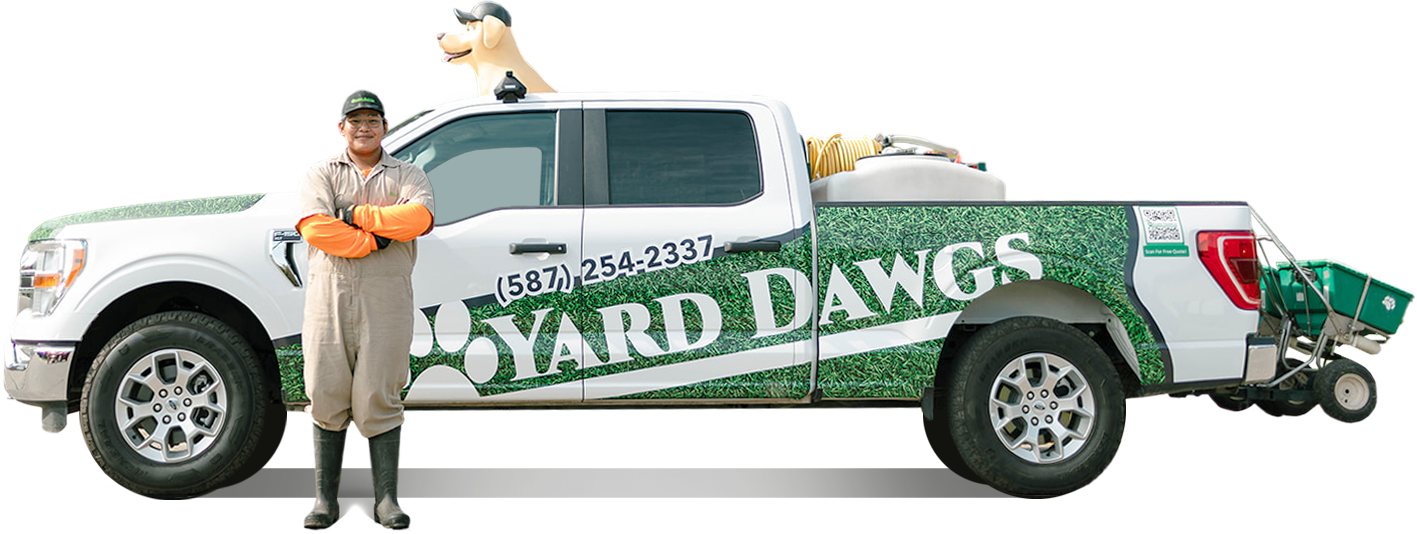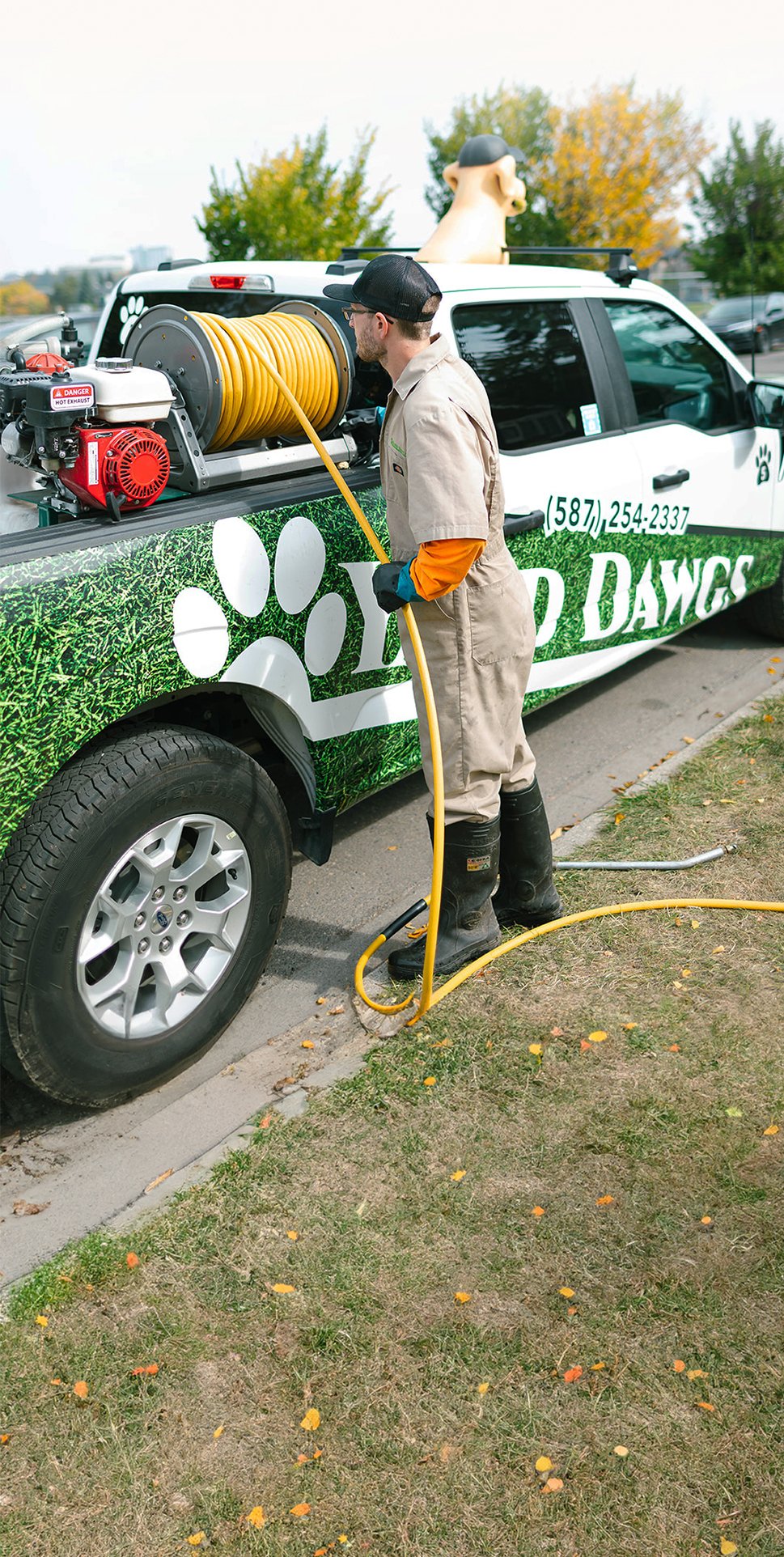Everything You Need To Know
When it comes to having a beautiful lawn, it is the little things that matter. Little things that often get in the way of enjoying a beautiful lawn are weeds. These weeds often appear at the most inconvenient times just as we are getting the lawn prepared for summer and can take a whole lot of effort to get rid of. Weeds are also smart, as years of evolution has allowed them to be resourceful, finding a way to establish themselves in any weak spot-on lawns.
There are many different types of weeds, which means that one of the most important steps in properly controlling weeds is weed identification. Many weeds can also look similar, such as different types of grassy weeds but require different management strategies as they reproduce in slightly different ways.
Before you dive into your journey in identifying and managing weeds, we recommend you download our comprehensive guide of The Top 15 Weeds Found in Alberta to get the most out of this article best help you meet your weed control goals!
Once you have downloaded the guide, return to this article where we will break down all the basics you need to know about weeds, including:
- What is a weed?
- The downside and upside to weeds
- How do weeds spread?
- Key weed terminology
- How to identify weeds
- How to manage weeds
Ready to learn all about weeds? Let's get started!
What is a weed?
A weed is simply a plant that is found in the wrong place at the wrong time. Typically, there are three different categories of weeds, including two official categories defined by the Alberta Weed and Control Act.
Category 1: Noxious Weeds
According to the Alberta Weed and Control act these weeds are “non-native species are already widely distributed in Alberta that have significant economic or ecological impact and can spread easily from existing infestations onto adjoining properties. Relatively easily controlled in small numbers, they can become unmanageable if left uncontrolled” .
In other words, these noxious weeds commonly invade soils in Alberta, and should be managed while weeds are small to avoid large infestations.
Category 2: Prohibited Noxious Weeds
According to the Alberta Weeds and Control act these weeds are “are non-native with currently restricted or local distribution in Alberta that present risks of spreading and causing significant economic or ecological impact. They are also non-native species not currently established in Alberta but that occur in neighboring jurisdictions, cause significant economic or ecological impact in those jurisdictions”
In other words, prohibited noxious weeds are that commonly invade, or could invade soils in Alberta and even small spread can cause significant ecological and economical impact.
The above two definitions are official designations of weeds as defined by the Alberta Weeds and Control Act. However, as a homeowner the weeds that you are encountering on a day-to-day basis are most likely not “official” weeds, but rather nuisance plants:
Nuisance Plants
These plants, or “weeds”, do not pose any immediate threat to humans, wildlife or biodiversity. They are simply considered a nuisance often due to aesthetic reasons and can easily invade residential areas.
The downside of weeds
For homeowners and commercial owners, lawns full of weeds are aesthetically unpleasing and some weeds can be toxic to pets and humans. These weeds can also infect gardens, compromising growth of other plants as weeds compete for soil, nutrients, water and sunlight.
In the agricultural sector, weeds especially those designated as noxious or prohibited noxious pose a significant threat to biodiversity, crop yields and animal health. In fact, it is estimated that Canada spends $2.2 billion on eradication of weeds and off-setting crop losses.
The upside of weeds
Is there really an upside to weeds? Technically, yes.
Like other plants, weeds require a certain set of soil conditions that can reveal important clues about the health and composition of your soil. For example, identifying weeds that thrive in soil with poor nitrogen content, or eroded soil can help diagnose the root of the weed infestation problem.
Additionally, proper identification of weeds is crucial to ensure that you don’t indirectly harm your lawn or biodiversity. As long as weeds are not noxious or prohibited noxious, certain nuisance plants such as the common milkweed can actually attract more pollinators to your lawn and garden. Therefore, controlling these plants but not eradicating them may bring more benefits to your lawn ecosystem.
How do weeds spread?
Why is it important to understand how weeds spread? It will allow you to properly control your weeds to avoid spreading seeds or roots that will simply result in more weeds. There are two main ways weeds spread.
Let’s go back to high school biology quickly. Plants can reproduce either through sexual or asexual reproduction and each has important implications for how you treat your weeds.
Sexual reproduction
Sexual reproduction requires a pollinator to fertilize eggs which will develop into viable seeds. In flowering plants, the innermost part of the flower contains the ovary, which contains the eggs of the plant. To become fertilized, the pollen from another flower must enter the ovary for a new seed to develop. Once developed, these seeds can be dispersed by wind, water or by animals.
Weed control for plants that reproduce via sexual reproduction involves deadheading the flowers and avoiding mowing over flowers as it will simply spread seeds and increase the number of weeds on your lawn. Hand-pulling can be effective, and usually requires a combination of mechanical and chemical control to eradicate these weeds.
Asexual reproduction
Asexual reproduction produces plants that are genetically identical to the parent plant and reproduce by propagation. Instead of requiring pollinators to develop seeds, different parts of the plants including roots, rhizomes, stems and leaves can produce a new plant.
Weed control for plants that reproduce via asexual reproductions involves includes being careful with hand-pulling, as it can be ineffective if the root or rhizome is left in the ground as it will simply continue to propagate new plants. Mowing may be effective in starving root nutrients and usually requires a combination of mechanical and chemical control to eradicate these weeds.
Understanding Key Weed Terminology
In the comprehensive Top 15 Weeds in Alberta guide, there is specific terminology that makes identifying, understanding and diagnosing the root issue of your weed problems easier. Here, we will define the key terminology that will make understanding how your weed functions a bit easier.
What is the difference between rhizomes and roots?
- Roots extend into the soil like an anchor. Their main role is structure and role to pull moisture and nutrients up from their tips to nourish the plant. Some plants that undergo asexual reproduction propagate by their roots.
- Rhizomes are underground stems, and often grow perpendicular to gravity. Unlike roots which pull moisture and nutrients, rhizomes store nutrients for the plant's future use. Rhizomes are the main way many perennial plants spread through asexual reproduction as they contain so many nutrients to support the plants growth.
What is the difference between taproots and a fibrous root system?
- A taproot system includes a single, main root that grows downwards and penetrates deeply into the soil. Weeds with a taproot system can be more difficult to get rid of as the plant above soil often breaks off, leaving the taproot in the soil which will only regenerate.
Fun fact: Taproots include vegetables such as carrots and beets which are modified for food production as they store a lot of carbohydrates (starch and fibre).
- A fibrous root system is closer to the soils surface, and is smaller, roots that branch out. Unless the soil is extremely dry, fibrous roots are typically easier to dislodge as they are shallower.
What is the difference between annual and perennial weeds?
- Annual weeds include chickweed, crabgrass, ragweed, spotted spurge, knotweed and bluegrass. They typically have a less extensive root system but will often leave many viable seeds that will result in new weed growth the following year.
- Perennial weeds include clovers, nettle, dandelions, plantain and ground ivy. Perennial weeds have a more extensive root systems, including tap roots that make them more difficult to control. They also leave viable seeds that results in new weed growth the following year. These weeds are most difficult to control.
How to identify weeds in your own lawn
After familiarizing yourself with the above terminology discussed in this blog post, you are ready to dive in to start identifying the weeds that are in your lawn.
If you haven’t already, download our free Top 15 Weeds in Alberta Guide to get started. They will cover the classification, plant description, soil habitat and suggested plan of action to get rid of these weeds and leave you with a beautiful, weed-free lawn.
The weeds included in the guide are the following:
- Leafy Spurge
- Yellow Toadfloax
- Purple Loosestrife
- Common Tansy
- Ox-Eye Daisy
- Perennial Sow Thistle
- Canada Thistle
- Dandelion
- Quack Grass
- Crabgrass
- Plantain
- Purslane
- Common Milkweed
- Tall Buttercup
- Giant Hogweed
What are the best preventative strategies against weeds?
The best strategy against weeds is to develop a thick, healthy and robust lawn that will outcompete the weeds. Then, mechanical strategies including hand pulling and mowing are the next line of defense to get rid of these invading plants. In fact, herbicide against nuisance plants in Alberta is not registered, meaning both lawn companies and homeowners need to rely on natural methods to decrease weeds.
Depending on the needs of your lawn based on the type of weeds growing, the best strategies will differ. Beyond the detailed suggestions specific to each weed type in the eBook, here are some general strategies that should get your lawn in tip-top, weed-free shape.
1. Fertilization, Aeration and Overseeding
Fertilization, aeration and overseeding are the cornerstones of establishing a robust, thick and healthy lawn. Adhering to a seasonal lawn fertilization, aeration and overseeding schedule is key in preventing weeds in the first place. The healthier and thicker a lawn is, the less likely weeds will invade and grow.
Fertilization provides key nutrients, including nitrogen, phosphorus and potassium that helps roots and shoots survive and thrive. Providing your soil with these nutrients helps them outcompete weeds as they will grow faster and thicker.
Aeration creates tiny holes in your lawn, which is essential in providing space for nutrients and microorganisms to nurture the soil. Aeration also helps decrease compacted soil, which some weeds thrive in.
Overseeding is a process of spreading additional grass seed over existing turf. The process strengthens the existing lawn by creating new seedlings that outcompete weeds for nutrients, moisture and beneficial microorganisms.
Together, these three work together as a team to prevent and limit weeds for establishing themselves in your lawn.
2. Hand-pulling
If you are pulling by hand, experts recommend that you do so when the soil is moist for easy pulling and to avoid leaving roots or rhizomes in the soil which can reproduce into new weeds. If the weed has a tap-root system (like dandelions), it is crucial to remove the entre root system at once to reduce the potential of the weed to grow again.
3. Mowing
Avoid mowing over weeds with seeds or flowers as this will spread seeds and cause more weeds. Otherwise, mowing is generally effective to deplete weeds of nutrient storage in rhizomes. Always make sure you keep a proper mowing height of around 4-5 cm to maintain a healthy lawn.
4. Compost
If you create your own compost for your lawn or garden, avoid contaminating your compost with weed clippings or mowing as seeds, rhizomes, roots or plant foliage can reproduce and recontamination your lawn. Otherwise, compost can be a great way to return nutrients to your garden and your lawn.
5. Watering
A proper watering schedule is crucial to nurture your lawn and discourage weeds that prefer dry, compact soils. Checkout our watering blog here about how to water your lawn for Alberta's climates for the best results.
Ultimately, when it comes to having a beautiful lawn, we know that it’s the little things that make the entire difference. These little things, including a weed-free lawn is not just aesthetically pleasing, but also important for the overall health and longevity of your lawn!











